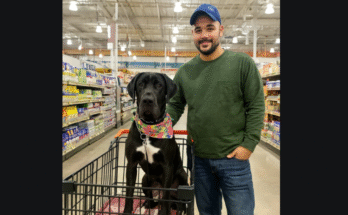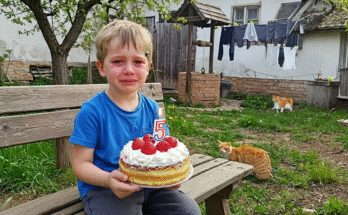Six months after my divorce, we adopted Tank from the shelter. They had labeled him “unadoptable”—he was too large, too strong, and had an “intimidating presence.” I did notice how he flinched when someone raised their voice and how gently he sat when my daughter, Leila, peeked at him through the kennel.
He didn’t bark; he simply waited. I decided to bring him home despite everyone’s warnings.
Leila, who was five at the time, hadn’t been able to sleep through the night since her dad left. The nightmares, bedwetting, and late-night sobbing were heartbreaking. We tried everything, including therapy, but nothing offered relief.
Then one night, she climbed onto the couch where Tank was sleeping, his legs sprawled like a tired old bear. She curled up next to him, whispering, “Don’t worry, I have nightmares too.” Tank didn’t move. She remained there all night.
From then on, she called him her “dream bouncer.” She explained that with Tank nearby, bad dreams couldn’t enter her space.
This arrangement worked until someone in the building complained. A neighbor reported that Tank was a dangerous dog, claiming her child was terrified of him. Management visited, clipboard in hand, and presented an ultimatum: remove the dog or face consequences. I looked at Tank—curled up with Leila, her fingers resting on his ear—and recognized my immediate course of action. I would not concede easily.
The next day, I began contacting friends knowledgeable about tenant rights and pet policies, then reached out to local shelters for guidance. Marcy from one shelter suggested I circulate a petition among neighbors. She indicated that sufficient support might prompt management to reconsider.
Armed with a clipboard, I approached residents door to door. Some neighbors were hesitant, having heard rumors, but others had observed Tank’s gentle nature. Mrs. Patel from the third floor recounted how Tank had nudged her dropped grocery bag back to her without breaking an egg. Mr. Alvarez mentioned seeing Leila laugh during their walks together. By day’s end, I had signatures from nearly half the building.
Leila continued to speak of her “dream bouncer” to anyone who would listen. She even created drawings of Tank warding off shadowy monsters, proudly asserting, “They’re afraid of him, even though he’s nice.” Her belief in Tank provided me with strength, but I remained apprehensive about the outcome. What if Tank had to return to the shelter—or worse?
A week later, we received another letter from management, granting us seven days to remove Tank or vacate the apartment. Leila burst into tears as I read it. “No one can take Tank!” she cried. “He’s part of our family!” I held her tightly, concealing my panic. “We’ll resolve this, sweetheart. I promise.”
That night, as we sat together on the couch, Tank abruptly stood and paced toward the front door. This restless behavior was uncharacteristic for him. Moments later, a knock sounded.
It was Greg, a neighbor from downstairs, holding a stack of papers. “Thought these might be useful,” he said gruffly. Inside were testimonials from parents whose children played safely around Tank, from elderly residents who appreciated his calm demeanor, and even from the maintenance worker who had fixed our sink. “He’s a good boy,” Greg added before departing.
I examined the papers, filled with a surge of hope, a feeling I hadn’t experienced in weeks.
On the sixth day, I entered management’s office with all the documentation I had collected: the petition, the testimonials, photographs of Tank with children, and a note from Leila’s therapist. I spread everything across the desk.
Ms. Harper, the manager, reviewed the materials, then sighed. “I understand your situation, but rules are rules.”
“Rules exist to safeguard people,” I responded. “Tank harms no one—he helps.”
She hesitated. “What if another complaint arises?”
“I’ll manage it,” I stated firmly. “I guarantee there will be no genuine complaints.”
She studied me for a long moment before nodding. “You have thirty days to demonstrate this works. Following that, we’ll re-evaluate.”
Relief washed over me. Thirty days was not an eternity, but it offered sufficient time to prove that Tank belonged with us—and within the community.
Over the subsequent month, circumstances shifted. More neighbors introduced themselves, some inquiring if Tank required additional treats (he always did). Children frequently stopped by to pet him. Even Ms. Harper’s demeanor softened, as she observed Tank’s gentle nature during an unannounced inspection.
One day, Leila returned home from school, grinning. “Guess what? My teacher says Tank should receive a medal for being a hero!”
“For what?” I inquired, chuckling.
“For deterring nightmares!” she replied matter-of-factly.
Her words resonated deeply. Tank was not merely a hero for Leila—he had become a hero to all who looked past his size and outward appearance.
The final meeting with management concluded more favorably than anticipated. Equipped with additional testimonials and glowing reports, I demonstrated that Tank was not simply a pet—he was a source of comfort and connection. When Ms. Harper asked if anyone had concerns, silence prevailed.
“Well,” she stated, “it appears you have presented a compelling case.”
As we departed, I felt lighter than I had in months. Tank was staying permanently.
Months later, life found a steady rhythm. Leila flourished, sleeping peacefully each night with Tank by her side. Her confidence grew, and she formed friendships at school. Tank became a neighborhood legend, even inspiring a mural of him on a local coffee shop, playfully dubbed the “Dream Bouncer Extraordinaire.”
One evening, as we observed the sunset from our balcony, Leila remarked, “Mommy, do you remember when they wanted to take Tank away?”
“I remember,” I replied, smiling.
“He showed everyone that sometimes the most intimidating appearances conceal the best protectors.”
Her innocence touched me profoundly. The situation extended beyond Tank alone—it centered on granting individuals and animals an opportunity to demonstrate their inherent worth, regardless of external judgment. It encompassed advocating for what truly matters, even when circumstances appear insurmountable.
And that is the message I wish to impart: Never underestimate the profound power of kindness, perseverance, and conviction. Occasionally, the most expansive hearts are found within the most unexpected packages.
If this story resonated with you, please share it and spread positivity. Let’s encourage others to champion their own “Tank.”




